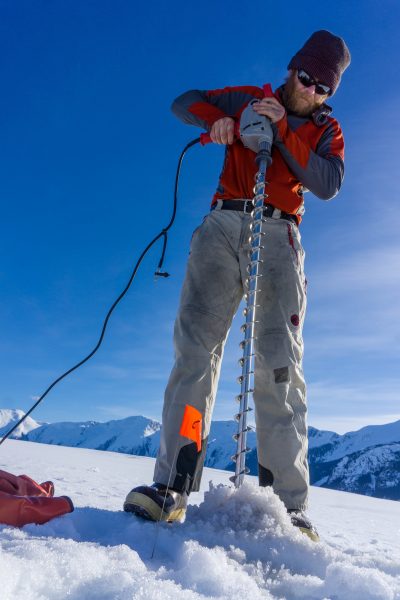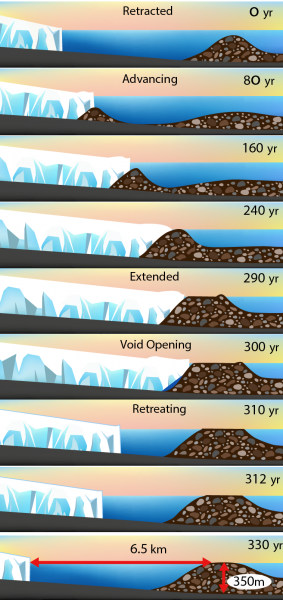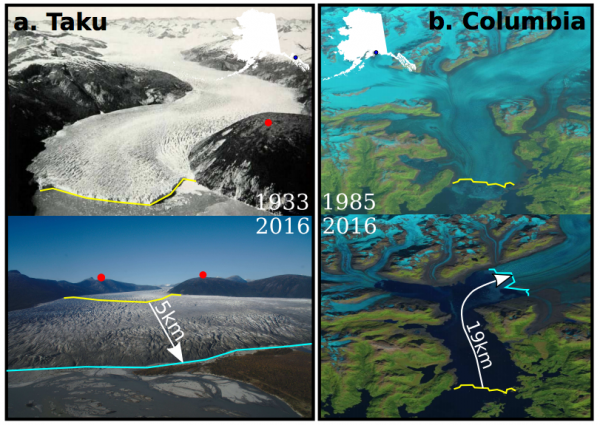A new model yields insights into glaciers' retreats and advances
July 20, 2017
Meghan Murphy
907-474-7541

A University of Alaska Fairbanks study looking at the physics of tidewater glaciers has yielded new insights into what drives their retreat-and-advance cycles and the role that climate plays in these cycles.
Lead author and UAF geophysics doctoral student Douglas Brinkerhoff said the study in Nature Communications reveals that shifting sediments drive the cycles among tidewater glaciers in temperate climates such as southern Alaska.
The study also reveals that these glaciers don’t need periods of warming within the temperate climates to trigger the glacier’s retreat, as previously thought.
“Tidewater glaciers can advance further into the ocean by riding on top of a pile of their own sediment, but this can get them into trouble,” said Brinkerhoff. “Eventually the glacier snout slows down, but it continues to push that sediment pile further out to sea, essentially pulling the rug out from under itself. When the glacier floats, there's no resistance at its base holding it back and the whole floating part tends to disintegrate."

The findings stem from a mathematical model that Brinkerhoff developed to better understand the periodic retreats and advances of glaciers that flow into the ocean. One-third of Alaska’s approximately 60 tidewater glaciers are advancing as part of this cycle, despite the otherwise widespread glacier loss. The advances usually last several centuries, while the retreats take only decades.
Co-author Martin Truffer, a glaciologist with UAF's Geophysical Institute, said that glaciologist Austin Post first noted the tidewater glacier cycles in the 1970s. He saw that sediment piles developed in the ocean in front of advancing glaciers. These piles allowed the glaciers to extend their advance, followed by often catastrophic collapse and retreat.
"While the work of Austin Post and others clearly showed that the erosion, evacuation and deposition of glacial sediments play an important role, the work reported here managed, for the first time, to capture all the relevant processes in one single model," said Truffer.
Brinkerhoff said that many scientists believed that warming periods within the temperate climate triggered the extended glacier to collapse. They thought that the extended part of the glacier was vulnerable to slight periods of warming because it was flatter and at sea level.
But the model shows that the extended portion of the glacier would collapse even without these warming periods because the glacier erodes the pile supporting it.
Co-author Andy Aschwanden, a modeler with UAF’s Geophysical Institute, said that tidewater glaciers in climates colder than Alaska, such as southeastern Greenland or the northern Antarctic Peninsula, generally do not exhibit a cycle yet.

“The model suggests if temperatures keep rising some of the tidewater glaciers in colder areas may start to advance, even though that seems counterintuitive,” Aschwanden said.
To develop and test the model, Brinkerhoff used observations from glaciers such as Prince William Sound's Columbia Glacier, which started retreating in 1985. He said they also looked at advancing tidewater glaciers such as Hubbard Glacier, which has a submarine pile in front of it, and Taku Glacier near Juneau, the terminus of which now rests on an exposed pile of sediment.
Brinkerhoff received a 2015 National Science Foundation Graduate Research Fellowship to pursue his study.
Additional Contacts: Douglas Brinkerhoff, douglas.brinkerhoff@gmail.com. Martin Truffer at 907-474-5359 or mtruffer2@alaska.edu.
Paper online: http://bit.ly/tidewaterglacier


